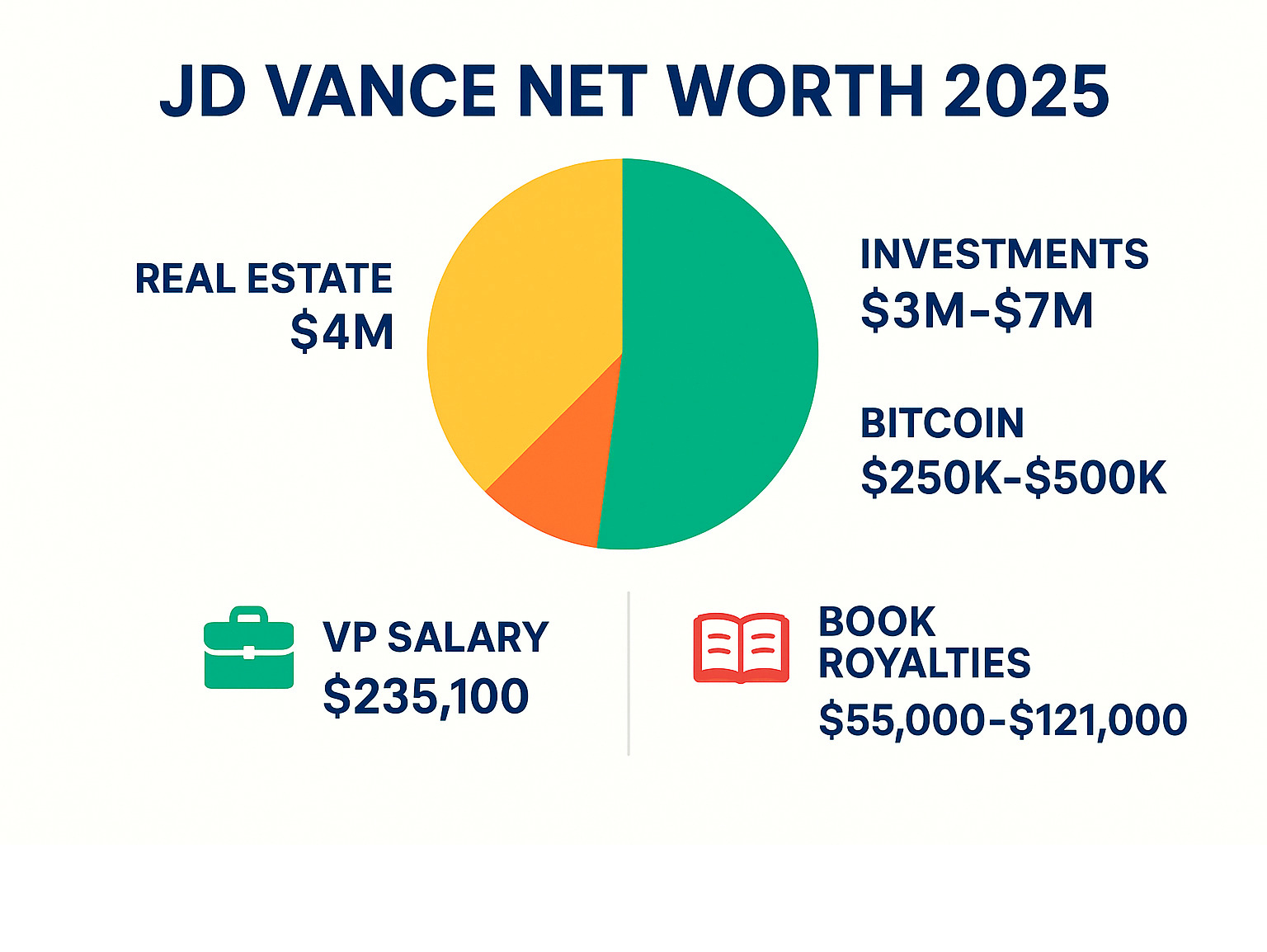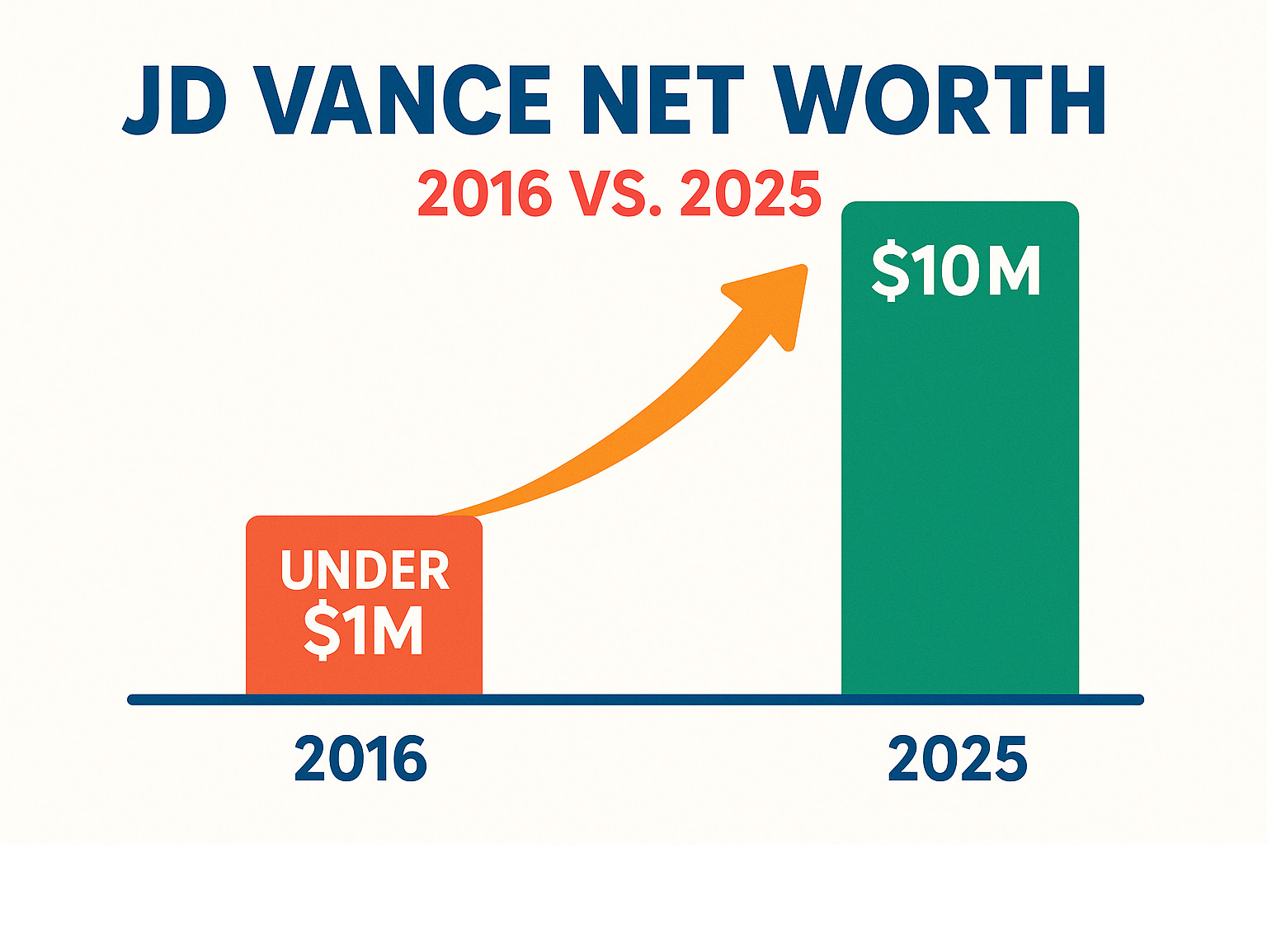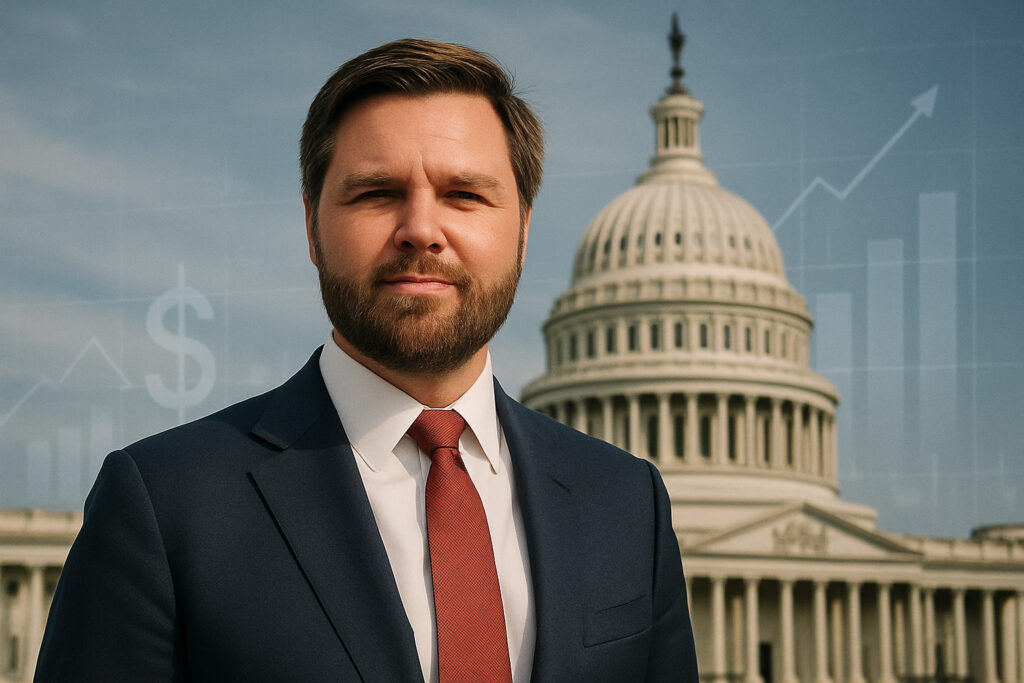Understanding JD Vance’s Financial Journey from Author to Vice President
JD Vance net worth is estimated at $10 million as of 2025, according to Forbes. The 40-year-old Vice President built his wealth through multiple income streams before entering the nation’s second-highest office.
Quick Facts About JD Vance’s Net Worth:
- Total Net Worth: $10 million (Forbes estimate)
- Asset Range: $4.1 million to $11.8 million (federal disclosures)
- Annual VP Salary: $235,100
- Real Estate Holdings: ~$4 million across three properties
- Book Royalties: $55,000-$121,000 annually from “Hillbilly Elegy”
- Bitcoin Holdings: $250,000-$500,000
- Venture Capital Stakes: $500,000-$1 million in Narya Capital
Vance’s financial story reflects a remarkable change from his childhood in Middletown, Ohio. His bestselling memoir “Hillbilly Elegy” sold over 3 million copies and launched multiple revenue streams including Netflix film rights, speaking engagements, and venture capital opportunities.
The Vice President’s wealth comes from four main sources: literary earnings, investment returns, real estate appreciation, and government salaries. His financial disclosures show a diversified portfolio spanning traditional investments, cryptocurrency, and property holdings across Washington D.C., Cincinnati, and Alexandria.
As one colleague noted about his venture capital days, Vance appeared more focused on “promoting his book than engaging in investments” – a strategy that ultimately paid off as his memoir became a cultural phenomenon and political launching pad.

JD Vance Net Worth 2025 Snapshot
The JD Vance net worth of $10 million tells a fascinating story of American opportunity and ambition. While this figure certainly represents substantial wealth by most standards, it places the Vice President in a unique position within today’s political landscape – wealthy enough to be financially secure, yet modest compared to the billionaire cabinet members surrounding him in the current administration.
This $10 million estimate comes from Forbes’ careful analysis of federal financial disclosure forms, which show his assets ranging between $4.1 million and $11.8 million. The wide range isn’t due to uncertainty about his finances – it’s simply how government disclosure forms work. Officials report their holdings in brackets rather than exact dollar amounts, creating some natural variation in the final calculations.
What makes Vance’s financial journey particularly compelling is how it mirrors the very themes he wrote about in his bestselling memoir. Growing up with economic uncertainty in Ohio, he once described feeling driven to build wealth because of childhood instability. “I wanted to make money — I’m not saying I’m anti-making money,” he explained, showing how his early experiences shaped his financial goals.
Focus Keyphrase: JD Vance Net Worth Overview
When we look at the JD Vance net worth trajectory from 2016 to 2025, we see steady growth that accelerated significantly after key career milestones. His wealth building started gaining momentum with his memoir’s publication, picked up steam during his venture capital years, and reached new heights following his Senate election in 2022 and subsequent vice presidential nomination.
The $10 million figure represents more than just financial success – it’s a testament to diversification and strategic thinking. Rather than relying on a single income source, Vance built wealth through multiple streams: book royalties, investment returns, real estate appreciation, and government salaries. This approach has created a solid financial foundation that continues generating income even as his career has shifted from private sector to public service.
The Role of ‘Hillbilly Elegy’ in Catapulting Wealth

“Hillbilly Elegy” didn’t just make JD Vance famous – it transformed his entire financial picture. The memoir became a cultural phenomenon, selling over 3 million copies by mid-2024 and creating multiple revenue streams that continue flowing years after publication.
The book’s financial impact has been both substantial and sustained. Between 2020 and 2021, Vance earned over $800,000 in royalties from HarperCollins, though these earnings have fluctuated with public interest in his story. In 2022, he reported $121,000 in royalties, which dropped to $55,000 in 2023, before surging again in 2024 following his vice presidential nomination.
The Netflix adaptation added another layer to his earnings. While Netflix paid $45 million for the film rights in 2019, Vance’s specific cut remains private. However, the film’s release starring Amy Adams and Glenn Close boosted book sales and liftd his public profile considerably.
This increased visibility opened doors to lucrative speaking engagements, with college appearances alone bringing in over $70,000. The combination of ongoing royalties, film rights, and speaking fees created a steady income stream that helped fund his political ambitions and build the foundation for his current $10 million net worth.
How JD Vance Built His $10 Million Fortune
Building a JD Vance net worth of $10 million didn’t happen overnight. His financial journey shows how smart diversification can turn one big break into lasting wealth. Instead of putting all his eggs in one basket, Vance created multiple income streams that work together like a well-oiled machine.
The beauty of his approach? Each income source reinforced the others. His book success opened doors to venture capital opportunities, which provided credibility for speaking engagements, which boosted his political profile – creating a virtuous cycle of wealth building.
Book & Film Earnings Breakdown
“Hillbilly Elegy” became Vance’s golden goose, but it laid more than one type of egg. The memoir didn’t just generate royalties – it created an entire ecosystem of earning opportunities.
During peak years (2020-2021), Vance pulled in $823,132 in royalties alone. That’s life-changing money for most people, but the amounts fluctuate dramatically based on current events and media attention. In 2022, he earned $121,000 in royalties, which dropped to $55,000 in 2023 before surging again in 2024 when his vice presidential nomination sent book sales through the roof.
The speaking circuit became another goldmine. Vance earned over $70,000 from just 18 college visits, proving that audiences were hungry to hear his story in person. These appearances often paid $3,000-$5,000 per event – not bad for sharing your life experiences.
Then came the Netflix deal. While the streaming giant paid $45 million for film rights in 2019, Vance’s exact cut remains under wraps. But the movie starring Amy Adams and Glenn Close boosted his profile enormously, creating a feedback loop that drove more book sales and speaking opportunities.
The timing couldn’t have been better. When HarperCollins announced his VP nomination, they sold 650,000 copies in just the first few days. That’s the kind of publicity money can’t buy.
Venture Capital & Other Investments
Vance’s venture capital career started at Mithril Capital, where he learned the ropes from Peter Thiel himself. But the real money came when he launched Narya Capital, his own $93 million fund focused on Midwest investments. Having Silicon Valley heavyweights like Thiel, Eric Schmidt, and Marc Andreessen backing your fund doesn’t hurt either.
His investment portfolio reads like a textbook on smart diversification. His Charles Schwab account holds between $2.3 million and $7.7 million in various securities – that’s his biggest single investment bucket. He’s also got $500,000 to $1 million in the Invesco QQQ Trust, which tracks the Nasdaq and gives him exposure to tech growth.
But Vance doesn’t just chase high-flying stocks. He’s got $100,000-$200,000 in 20+ year Treasury ETFs for stability, plus $50,000-$100,000 in Walmart shares for steady dividend income. It’s the kind of balanced approach that lets you sleep well at night.
For those interested in Scientific research on investing diversification, Vance’s portfolio demonstrates exactly why spreading your bets across different asset classes and time horizons makes sense.
Political Salaries: Senator to Vice President
Government paychecks might not make you rich, but they provide something equally valuable: predictable income. Vance’s Senate salary of $174,000 annually jumped to $235,100 as Vice President – a nice 35% raise that reflects the step up in responsibility.
These salaries represent a relatively small slice of his total wealth, but they serve an important purpose. Having steady government income means Vance can take bigger risks with his investments, knowing he’s got reliable cash flow to cover living expenses.
Plus, there’s the long-term benefit of federal pension contributions and health benefits. It’s not glamorous, but it’s the kind of financial foundation that lets you build wealth more aggressively elsewhere.
Real Estate & Crypto Portfolio

Real estate makes up about 40% of Vance’s net worth, with three properties totaling around $4 million. His strategy here shows both political savvy and financial smarts.
His Washington D.C. townhouse tells an interesting story. Bought for $590,000 in 2014, it’s now worth $850,000 – a solid return that also generates $15,000-$50,000 annually in rental income. He still owes about $480,000 on the mortgage, but the property pays for itself while building equity.
The Cincinnati home cost $1.4 million in 2018 and is now valued at $1.8 million. This serves as his Ohio political base – you can’t represent a state without living there, after all. It’s both a smart investment and a political necessity.
His newest purchase, an Alexandria property bought for $1.6 million in 2023, shows strategic thinking. Now worth $1.8 million, it provides convenient access to Washington while maintaining some distance from the political fishbowl of D.C. proper.
Then there’s his Bitcoin holdings – between $250,000 and $500,000 worth. This represents a measured approach to cryptocurrency. It’s significant enough to benefit from potential appreciation but not so large that volatility could wreck his overall financial picture.
For more insights into how successful couples manage their finances together, check out our More info about Usha Vance. Her background in law and finance likely influences many of their investment decisions, creating a true financial partnership.
Assets, Liabilities & Year-by-Year Growth
When we look at the complete picture of JD Vance net worth, it’s important to understand that his $10 million fortune isn’t just sitting in a bank account. Like most wealthy individuals, Vance has built a complex financial portfolio that includes both valuable assets and strategic debt.
His total assets range from $4.1 million to $11.8 million according to federal disclosure forms, but he also carries between $750,000 and $1.5 million in liabilities. This might sound concerning, but it’s actually a smart financial strategy when you understand the details.
The growth story is particularly impressive when you consider where Vance started. In 2016, when “Hillbilly Elegy” was first published, his net worth was likely under $1 million. By 2025, he’s built a $10 million portfolio – that’s roughly 900% growth in less than a decade.
Liquid vs. Fixed Assets
Vance has done something really smart with his money – he’s spread it across different types of investments to balance growth with security. Think of it like not putting all your eggs in one basket.
His liquid assets – money he can access relatively quickly – include his brokerage accounts worth $2.3 to $7.7 million. These contain stocks, bonds, and other investments he can sell if needed. He also keeps $200,000 to $500,000 in regular bank accounts for everyday expenses and emergencies.
His retirement planning shows forward thinking too, with a SEP-IRA account holding $100,000 to $250,000. And yes, he’s even got skin in the crypto game with Bitcoin holdings between $250,000 and $500,000.
The fixed assets tell an interesting story about his long-term strategy. After accounting for mortgage debt, his real estate equity sits around $2.5 to $3 million. His venture capital stakes worth $500,000 to $1 million are essentially locked up for years, but they could pay off big if his investments succeed.
This balance gives Vance the best of both worlds – he can take advantage of new opportunities while still having cash available when life throws curveballs.
Debt & Risk Profile
Here’s where Vance’s childhood experiences with financial instability might have shaped his adult money management. His debt structure is surprisingly conservative for someone with his wealth level.
His mortgage debt ranges from $250,000 to $500,000 across his three properties. He also has access to a line of credit worth $500,000 to $1 million, though it’s unclear how much he’s actually using.
The math works out to a leverage ratio of roughly 15-20% – meaning his debt is only about one-fifth of his total assets. Most financial experts consider anything under 30% to be conservative, so Vance is playing it pretty safe.
This cautious approach makes sense when you remember his background. Growing up with economic uncertainty probably taught him the value of financial stability over maximum returns. He’s wealthy enough to take some risks, but smart enough not to bet the farm.

Comparing JD Vance’s Wealth to Other U.S. Politicians
When we look at the JD Vance net worth of $10 million, it’s fascinating to see where he fits in the political wealth landscape. He’s definitely not at the top of the heap – President Trump’s estimated $6.7 billion fortune makes Vance’s wealth look like pocket change in comparison.
But here’s the interesting part: Vance sits comfortably above the median Congressional net worth of about $1.2 million. This puts him in what you might call the “Goldilocks zone” of political wealth – not too rich, not too poor, but just right for maintaining both financial independence and some connection to everyday Americans.
Compare him to other political figures like Mike Pence or Marco Rubio, and you’ll find similar wealth levels. It seems there’s a sweet spot for politicians who want to appear successful without seeming completely out of touch.
Contextualizing the $10 Million Figure
To really understand what $10 million means, let’s break it down in real terms. This amount places Vance in roughly the top 1% of American households – no small feat considering the median U.S. household net worth hovers around $193,000.
That means his wealth is approximately 50 times the national median. It’s the kind of money that provides serious financial security and opens doors that remain closed to most Americans.
Yet within the marble halls of Washington D.C., $10 million represents moderate wealth. Many senators and cabinet members have accumulated much larger fortunes through decades in business before entering politics. Vance’s relatively recent wealth accumulation – mostly since “Hillbilly Elegy” became a phenomenon – sets him apart from career politicians who’ve been building wealth for decades.
Public Perception & Policy Influence
Vance’s wealth level creates a fascinating balancing act for his political brand. His memoir’s central narrative revolves around humble beginnings in Middletown, Ohio, and the bootstrap journey to success. This resonates powerfully with voters who believe in the American Dream and economic mobility.
However, critics naturally question whether someone with a $10 million net worth can authentically represent working-class concerns. Can you really understand the struggle of choosing between groceries and gas when you own multiple properties and have cryptocurrency holdings?
The transparency of his financial disclosures helps address these concerns somewhat. Unlike some politicians who try to downplay their wealth, Vance’s disclosure forms provide detailed breakdowns of assets and income sources. This openness allows for public scrutiny of potential conflicts of interest – a crucial element in maintaining public trust.
His populist branding walks a careful line between celebrating success and staying grounded in his roots. The fact that his wealth comes primarily from a book about his own struggles creates an interesting narrative tension that will likely follow him throughout his political career.
For additional perspectives on how public figures steer transparency and public trust, our analysis of More info about Scamanda explores the complex relationship between financial disclosure and credibility.
For more detailed analysis of political wealth comparisons, TheWeek.com provides comprehensive coverage of how Vance’s financial position compares to other political figures.
Frequently Asked Questions About JD Vance Net Worth
When it comes to JD Vance net worth, people have plenty of questions. His financial journey from struggling childhood to millionaire Vice President raises natural curiosity about the details behind the numbers.
How accurate are his financial disclosures?
Vance’s financial disclosures follow federal requirements that demand detailed reporting from government officials. These forms provide a comprehensive look at his assets, income sources, and potential conflicts of interest – though they’re not perfect.
The disclosure system uses broad ranges rather than exact figures. For example, an asset might be listed as “$100,000-$250,000” instead of the precise amount. This creates some wiggle room in calculating his exact net worth.
However, multiple financial analysts have reviewed his forms and consistently arrive at similar conclusions. The $10 million JD Vance net worth estimate appears well-supported by the available data. His transparency level exceeds many politicians who tend to minimize their wealth or provide vague details.
Does JD Vance hold significant cryptocurrency beyond Bitcoin?
Current disclosures show only Bitcoin holdings valued between $250,000-$500,000. If he owns other cryptocurrencies, they either fall below the reporting thresholds or are tucked into broader investment categories.
His approach to digital assets seems measured and conservative. Rather than diving into speculative altcoins or trendy crypto projects, he’s stuck with Bitcoin – the most established cryptocurrency. This aligns with his overall investment philosophy of balancing growth potential with stability.
The absence of other crypto holdings in his disclosures suggests he views Bitcoin as a portfolio diversifier rather than embracing cryptocurrency as a major wealth-building strategy.
How might future book deals affect his net worth?
A second book could dramatically boost the JD Vance net worth figure. His liftd profile as Vice President would likely attract substantial publisher interest and advance offers. Political memoirs by high-profile figures routinely command seven-figure advances.
“Hillbilly Elegy” has already sold over 3 million copies and continues generating royalties nearly a decade after publication. A follow-up book about his political journey, written from the Vice President’s perspective, could easily match or exceed those numbers.
However, book success isn’t guaranteed. Market demand depends on political developments, public interest in his story, and timing of publication. His current bestseller status provides negotiating leverage, but future sales would ultimately depend on readers’ appetite for his continued narrative.
The publishing industry has changed significantly since his first book launched. While his platform is stronger, the market is more crowded with political memoirs competing for attention.
Conclusion
The JD Vance net worth story reads like a modern American dream – complete with humble beginnings, unexpected success, and strategic financial decisions that built a $10 million fortune. From his childhood in Middletown, Ohio to the Vice President’s residence, Vance’s journey shows how combining talent, timing, and smart money moves can create lasting wealth.
What makes his financial story particularly interesting is how he built wealth across multiple channels. His book royalties from “Hillbilly Elegy” opened doors to venture capital opportunities, which led to diversified investments, all while building a real estate portfolio and eventually earning government salaries. This approach – not putting all eggs in one basket – offers valuable lessons for anyone building wealth.
His transparency in financial disclosure deserves recognition too. While some politicians hide their wealth or downplay their success, Vance’s detailed federal forms let voters see exactly where his money comes from and where potential conflicts might exist. This openness builds trust and sets a good example for public service.
Looking ahead, the JD Vance net worth will likely keep growing through his VP salary of $235,100, ongoing book royalties, and investment returns. His Bitcoin holdings and real estate properties could appreciate significantly over time. However, his political future may depend on staying connected to middle-class voters despite his millionaire status.
The Vice President’s wealth trajectory also reflects broader trends in American success stories. Today’s fortunes often come from mixing creative work (like writing bestsellers) with strategic investments (like his venture capital stakes) and career advancement (from lawyer to senator to VP). His story proves that significant wealth building remains possible, even for those starting without advantages.
At Beyond Beauty Lab, we find these financial success stories inspiring because they show real strategies that work. Whether you’re building wealth through creative projects, smart investments, or career growth, the principles of diversification and transparency that Vance used can guide your own financial journey.
His path from uncertain childhood to the nation’s second-highest office reminds us that financial success often comes from unexpected combinations – who would have predicted that a memoir about growing up poor would launch a political career worth $10 million? Sometimes the best financial strategy is simply being authentic about your story and working hard to share it with the world.







